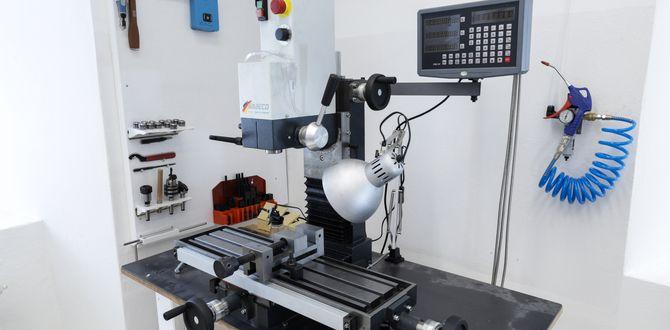Carbide end mills, especially those designed for G10 like the Genius G10 tools, are essential for precise machining of this tough laminate. They offer superior durability and sharpness, cutting through G10 effectively for intricate details and tight tolerances, making them a top choice for hobbyists and professionals alike.
Hey there, fellow makers! Daniel Bates here from Lathe Hub. Ever tried to cut G10 fiberglass laminate and ended up with a frustrating mess? It’s a common challenge, especially when precision is key. G10 is tough stuff, and using the wrong tool can lead to chipped edges, dull bits, and a whole lot of work down the drain. But what if I told you there’s a game-changer for working with this material? Today, we’re diving deep into the world of carbide end mills, specifically focusing on what makes “Genius G10 Tools” so brilliant for your projects. Get ready to transform your G10 machining experience!
What is G10 and Why is it Tricky to Machine?
Before we jump into the tools, let’s quickly chat about G10 itself. G10 is a high-pressure thermoset laminate. It’s made by layering woven fiberglass cloth with an epoxy resin and then compressing it under high heat and pressure. Think of it like super-strong fiberglass.
imagine it like this:
- Material Composition: Fiberglass and epoxy resin
- Key Properties: Incredible strength, excellent electrical insulation, good heat resistance, and high rigidity.
- Common Uses: Knife handles, circuit boards, industrial electrical insulation, and even some aerospace components.
Sounds great, right? Well, it is great for its intended applications. However, when it comes to machining, this very strength and density become a challenge. The epoxy resin can melt and gum up a dull or inappropriate cutting tool. The fiberglass fibers, when cut improperly, can fray and chip. This means you need a tool that’s not only sharp but also durable enough to withstand the abrasive nature of the material without generating excessive heat.
The Magic of Carbide: Why It’s the Midas Touch for G10
This is where carbide end mills come into play. When we talk about machining tough materials like G10, uncoated, high-quality solid carbide end mills are often the go-to choice. Why carbide? It’s all about its incredible hardness and ability to retain sharpness.
Carbide vs. HSS (High-Speed Steel)
You might be familiar with High-Speed Steel (HSS) tools. They’ve been a staple for a long time. However, for materials like G10, carbide generally outperforms HSS:
- Hardness: Carbide is significantly harder than HSS. This means it can cut through tough materials like G10 more easily and stay sharp for longer.
- Heat Resistance: Carbide can withstand higher temperatures during cutting. This is crucial because machining G10 can generate heat, and a tool that can handle it will cut cleaner and last longer.
- Rigidity: Carbide is also more rigid. This means less flex and vibration, leading to more precise cuts and a better surface finish.
For G10, this translates to cleaner cuts, less material melting, and a much longer tool life compared to HSS. It’s an investment that pays off quickly in terms of results and saved frustration.
“Genius G10 Tools”: What Makes Them “Genius”?
The term “Genius G10 Tools” isn’t just a catchy name; it refers to end mills specifically engineered to tackle G10 and similar composite materials. These tools often incorporate specific features that make them ideal:
- Geometry: The cutting edge geometry is optimized for composite materials. This often means sharper edges and specific flute forms designed to evacuate chips efficiently and prevent heat buildup.
- Coatings: While some are uncoated (which are excellent for G10), some high-performance end mills might feature specialized coatings designed to reduce friction, increase hardness, and improve chip evacuation. For G10, uncoated carbide is often preferred by many, but it’s good to know options exist.
- Flute Count: Typically, 2-flute or 4-flute designs are common. For G10, 2-flute uncoated mills are very popular because they offer excellent chip clearance and are less prone to clogging, which is a major issue with sticky materials.
- Material Quality: They are made from high-quality, fine-grain carbide that provides a superior balance of hardness and toughness.
These features combine to create an end mill that cuts G10 with remarkable ease and precision, minimizing the common problems associated with machining this material.
Key Features to Look For in a Carbide End Mill for G10
When you’re shopping for a carbide end mill specifically for G10, keep these critical features in mind. These are the things that will directly impact your success and the quality of your work.
Shank Diameter: The Foundation of Your Cut
The shank is the part of the end mill that gets held in your collet or chuck. For G10, you’ll often see options like 1/8 inch (3.175mm) and 10mm shanks. The choice here often depends on your machine’s capabilities and the size of the features you need to create.
- 1/8 inch Shank: This is a very common size, especially for smaller CNC machines and hobby setups. It allows for fine detail work and is great for detailed engraving or small cutouts. However, smaller diameter shanks mean smaller tool engagement, which can affect rigidity.
- 10mm Shank: A larger shank diameter like 10mm provides greater rigidity and strength. This is beneficial when you need to take more aggressive cuts, machine wider slots, or work with larger diameter end mills where the cutting forces are higher. It also means you’ll need a collet or chuck that can accommodate a 10mm shank.
Length: Reaching New Depths (or Staying Close)
End mills come in various lengths, and “stub length” is a term you’ll frequently encounter. This relates to the overall length and, more importantly, the length of the cutting flutes relative to the shank.
- Stub Length: These end mills have shorter flute lengths compared to their overall length. This shorter length often means a more robust tool that is less prone to deflection and vibration. For tough materials like G10, where rigidity is paramount to get clean cuts and avoid chipping, stub length end mills are often preferred. They excel in situations where you don’t need to cut very deep.
- Standard Length: These have longer flute lengths, offering more reach. If your project requires cutting deeper than a stub length tool allows, a standard length might be necessary. However, be mindful that longer tools can be more flexible and prone to chatter or deflection, especially in hard materials.
End Mill Geometry & Flutes
This is where the “Genius” really comes into play for G10. The specific design of the cutting edges and the number of flutes are tailored for composites.
- Flute Count:
- 2-Flute: Often the best choice for G10. The two wide flutes provide excellent chip evacuation, which is crucial for preventing heat buildup and the messy resin melting/gumming. Less tooth engagement means less heat.
- 4-Flute: Can be used, but often result in more heat generation due to more cutting edges engaged at once. They can provide a smoother finish but require careful managing of feed rates and speeds for G10.
- Edge Geometry: Look for sharp, clean cutting edges. Some end mills designed for composites might have a slight positive rake angle to “slice” through the G10 rather than “tear” it.
- Uncoated vs. Coated:
- Uncoated Solid Carbide: For G10, this is often the gold standard. The pure sharp edge of the carbide, when properly manufactured, is incredibly effective.
- Specialty Coatings (e.g., TiCN, ZrN): While often used for metals, specific coatings can sometimes enhance performance on composites by reducing friction and increasing surface hardness. However, for many, the clean uncoated edge is preferred for G10.
Tip Style: Square, Ball, or Corner Radius
The shape of the tip determines the type of cuts you can make and the corners you’ll achieve.
- Square End Mill: These have a flat bottom and sharp 90-degree corners. They are perfect for cutting slots, pockets, and profiles where sharp internal corners are desired.
- Ball End Mill: These have a rounded tip. They are excellent for 3D contouring, creating curved surfaces, and drilling operations.
- Corner Radius End Mill: These are a hybrid, featuring a flat tip with a small radius on the corners. They combine the slotting capability of a square end mill with the ability to create slightly rounded, stronger internal corners, which can reduce stress risers and chipping. For G10, a corner radius can be a good compromise for durability and detail.
Tolerances and Precision: The “Tight Tolerance” Advantage
The keyword “tight tolerance” in relation to carbide end mills for G10 is important. It implies that these tools are manufactured to very precise dimensions and runout specifications. This means:
- Consistency: You can expect predictable cutting performance and repeatable results.
- Accuracy: The tool will cut exactly where you tell it to, allowing for intricate designs and perfect fits for components.
- Reduced Chatter: High-quality manufacturing leads to better balance and less vibration, crucial for smooth finishes and accuracy in tough materials.
When you’re aiming for precision in your G10 projects, choosing end mills explicitly designed for tight tolerances is a must. Cheaper, less precise tools will introduce variability, making it incredibly difficult to achieve professional-grade results.
Practical Application: Cutting G10 Safely and Effectively
Now that we understand the features, let’s get practical. How do you actually use these “Genius G10 Tools” for the best results?
Machine Setup is Key
A stable machine and fixturing are non-negotiable. G10 can be abrasive and unforgiving. Ensure your workpiece is held down securely to prevent any shifting during the cut. A good vacuum table or robust clamps are your best friends here.
Speeds and Feeds: Finding the Sweet Spot
This is often the trickiest part for beginners. There’s no single magic number, as it depends on your machine, the specific end mill, and the depth of cut. However, here are general guidelines for carbide end mills on G10:
General Recommendations for Carbide End Mills on G10
| Parameter | Typical Range / Recommendation | Notes |
|---|---|---|
| Spindle Speed (RPM) | 12,000 – 24,000 RPM (for smaller CNCs) | Higher speeds are generally better for carbide, but ensure your machine can achieve them reliably. |
| Feed Rate (IPM or mm/min) | Start conservatively: 20-60 IPM (500-1500 mm/min) for a 1/8″ end mill. Adjust based on chip load. | A good rule of thumb for chip load (material removed per flute) is 0.001″ – 0.002″ for small diameter bits. Listen to the cut! |
| Depth of Cut (DOC) | Shallow: 50-100% of the tool diameter for roughing, but less for finishing. | For G10, taking lighter passes is often better. For finishing passes, you might only need 0.005″ to 0.010″ (0.1mm to 0.25mm). |
| Climb vs. Conventional Milling | Climb milling is often preferred for composites. | Climb milling tends to produce a better surface finish and reduce tool pressure, but ensure your machine has zero backlash. |
| Cooling/Lubrication | Air blast is usually sufficient. Avoid fluid coolants that can make a mess with G10. | The primary goal is to remove chips and prevent melting. |
Important Beginner Tip: Always start with lighter cuts and slower feed rates than you think you need. Listen to your machine. If you hear excessive chattering or see signs of melting, back off the feed rate or reduce the depth of cut immediately. You can always increase these parameters once you’re confident in the cut.
For a fantastic resource on understanding Speeds and Feeds, check out this guide from Iscar (PDF download – a major tooling manufacturer). While it covers a broader range, the principles of chip load and surface speed still apply.
Chipload: The Secret Sauce
Chip load is the thickness of the material removed by each cutting edge of the end mill as it rotates. For G10, you want a chip load that is thick enough to remove material efficiently but not so thick that it overloads the tool or generates excessive heat.
The general formula is:
Chip Load = (Feed Rate) / (Spindle Speed * Number of Flutes)
Aiming for a chip load of around 0.001″ to 0.002″ (0.025mm to 0.05mm) for smaller diameter end mills in G10 is a good starting point. Adjust based on the results.
Dust Collection: Protect Yourself and Your Machine
Machining G10 produces fine dust. It’s absolutely critical to manage this dust:
- Health: The dust can be an irritant and can contain fine fiberglass particles and resin dust. Always wear appropriate respiratory protection (an N95 mask or better).
- Machine Cleanliness: Fine dust can get into the moving parts of your machine, causing wear and potential malfunctions.
- Work Area: Keep your workshop clean and tidy.
A good dust collection system attached to your CNC spindle or router is highly recommended. For manual milling, a shop vac with a fine dust filter can help capture dust as it’s generated.
Common Problems and How to Solve Them
Even with the right tools, you might run into issues. Here’s how to troubleshoot:
- Melting/Gummy Residue on the End Mill:
- Cause: Too much heat, too slow feed rate, or dull tool.
- Solution: Increase feed rate, reduce depth of cut, ensure the end mill is sharp, or try a different end mill geometry (e.g., 2-flute for G10). Make sure your spindle speed isn’t too low relative to your feed rate.
- Chipping or Fraying Edges:
- Cause: Excessive tool pressure, dull tool, or improper cutting direction.
- Solution: Use climb milling, reduce depth and width of cut, ensure the tool is sharp, and consider a corner radius end mill if sharp inside corners are not critical.
- Poor Surface Finish:
- Cause: Chatter, dull tool, or incorrect speeds and feeds.
- Solution: Ensure rigid setup, slow down spindle speed or increase feed rate to increase chip load (carefully!), use a finishing pass with a very light depth of cut.
- Tool Breakage:
- Cause: Too aggressive cut (depth or width), weak fixturing, lack of rigidity, or trying to cut too fast.
- Solution: Reduce all cutting parameters (DOC, feed), ensure workpiece is firmly held, use a more robust end mill (e.g., stub length, larger diameter if possible), or ensure your machine is properly tram- ed.
FAQ: Your Beginner Questions Answered
Q1: What’s the best type of end mill for G10?
A1: For G10, high-quality, uncoated solid carbide end mills, especially those with a 2-flute design, are generally considered the best. They offer sharpness, durability, and excellent chip evacuation.
Q2: Should I use a coated or uncoated end mill for G10?
A2: Uncoated solid carbide is often preferred for G10 because it provides a very sharp





